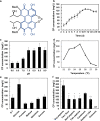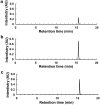Enhanced cercosporin production by co-culturing Cercospora sp. JNU001 with leaf-spot-disease-related endophytic bacteria
- PMID: 33992112
- PMCID: PMC8126151
- DOI: 10.1186/s12934-021-01587-2
Enhanced cercosporin production by co-culturing Cercospora sp. JNU001 with leaf-spot-disease-related endophytic bacteria
Abstract
Background: Owing to the excellent properties of photosensitization, cercosporin, one of naturally occurring perylenequinonoid pigments, has been widely used in photodynamic therapy, or as an antimicrobial agent and an organophotocatalyst. However, because of low efficiency of total chemical synthesis and low yield of current microbial fermentation, the limited production restricts its broad applications. Thus, the strategies to improve the production of cercosporin were highly desired. Besides traditional optimization methods, here we screened leaf-spot-disease-related endophytic bacteria to co-culture with our previous identified Cercospora sp. JNU001 to increase cercosporin production.
Results: Bacillus velezensis B04 and Lysinibacillus sp. B15 isolated from leaves with leaf spot diseases were found to facilitate cercosporin secretion into the broth and then enhance the production of cercosporin. After 4 days of co-culture, Bacillus velezensis B04 allowed to increase the production of cercosporin from 128.2 mg/L to 984.4 mg/L, which was 7.68-fold of the previously reported one. Lysinibacillus sp. B15 could also enhance the production of cercosporin with a yield of 626.3 mg/L, which was 4.89-fold higher than the starting condition. More importantly, we found that bacteria B04 and B15 employed two different mechanisms to improve the production of cercosporin, in which B04 facilitated cercosporin secretion into the broth by loosening and damaging the hyphae surface of Cercospora sp. JNU001 while B15 could adsorb cercosporin to improve its secretion.
Conclusions: We here established a novel and effective co-culture method to improve the production of cercosporin by increasing its secretion ability from Cercospora sp. JNU001, allowing to develop more potential applications of cercosporin.
Keywords: Cercosporin; Co-culture; Endophytic bacteria; Microbial fermentation; Secretion.
Conflict of interest statement
The authors declare that they have no competing interests.
Figures







Similar articles
-
Distribution and Sequestration of Cercosporin by Cercospora cf. flagellaris.Phytopathology. 2024 Aug;114(8):1822-1831. doi: 10.1094/PHYTO-09-23-0310-R. Epub 2024 Aug 1. Phytopathology. 2024. PMID: 38700938
-
Identification and characterization of Cercospora beticola necrosis-inducing effector CbNip1.Mol Plant Pathol. 2021 Mar;22(3):301-316. doi: 10.1111/mpp.13026. Epub 2020 Dec 23. Mol Plant Pathol. 2021. PMID: 33369055 Free PMC article.
-
The AVR4 effector is involved in cercosporin biosynthesis and likely affects the virulence of Cercospora cf. flagellaris on soybean.Mol Plant Pathol. 2020 Jan;21(1):53-65. doi: 10.1111/mpp.12879. Epub 2019 Oct 23. Mol Plant Pathol. 2020. PMID: 31642594 Free PMC article.
-
Photoactivated perylenequinone toxins in fungal pathogenesis of plants.FEMS Microbiol Lett. 2005 Nov 15;252(2):197-206. doi: 10.1016/j.femsle.2005.08.033. Epub 2005 Sep 6. FEMS Microbiol Lett. 2005. PMID: 16165316 Review.
-
Cercospora leaf spot disease of sugar beet.Plant Signal Behav. 2023 Dec 31;18(1):2214765. doi: 10.1080/15592324.2023.2214765. Plant Signal Behav. 2023. PMID: 37209061 Free PMC article. Review.
Cited by
-
Development of Biotechnological Photosensitizers for Photodynamic Therapy: Cancer Research and Treatment-From Benchtop to Clinical Practice.Molecules. 2022 Oct 13;27(20):6848. doi: 10.3390/molecules27206848. Molecules. 2022. PMID: 36296441 Free PMC article. Review.
-
Contribution of endophytes towards improving plant bioactive metabolites: a rescue option against red-taping of medicinal plants.Front Plant Sci. 2023 Sep 12;14:1248319. doi: 10.3389/fpls.2023.1248319. eCollection 2023. Front Plant Sci. 2023. PMID: 37771494 Free PMC article. Review.
-
Stimulating fungal cell wall integrity by exogenous β-glucanase to improve the production of fungal natural products.Appl Microbiol Biotechnol. 2022 Nov;106(22):7491-7503. doi: 10.1007/s00253-022-12224-2. Epub 2022 Oct 14. Appl Microbiol Biotechnol. 2022. PMID: 36239763
-
Enhanced production of aspochalasin D through genetic engineering of Aspergillus flavipes.Appl Microbiol Biotechnol. 2023 May;107(9):2911-2920. doi: 10.1007/s00253-023-12501-8. Epub 2023 Apr 1. Appl Microbiol Biotechnol. 2023. PMID: 37004567
References
-
- Daub ME. Cercosporin, a photosensitizing toxin from Cercospora species. Phytopathol. 1982;72:370–374. doi: 10.1094/Phyto-72-370. - DOI
-
- Fajola AO. Cercosporin, a phytotoxin from Cercospora spp. Physiol Plant Pathol. 1978;13:157–164. doi: 10.1016/0048-4059(78)90029-2. - DOI
-
- Kuyama S, Tamura T. Cercosporin. A pigment of Cercosporina Kikuchii Matsumoto et Tomoyasu. I. Cultivation of fungus, isolation and purification of pigment. J Am Chem Soc. 1957;79:5725–5726. doi: 10.1021/ja01578a038. - DOI
-
- Chupp TC. Notes on some Cercosporae of India. Mycologia. 1948;40:352–362. doi: 10.1080/00275514.1944.12017713. - DOI
-
- Reznikov S, De Lisi V, Claps P, González V, Devani MR, Castagnaro AP, Ploper LD. Evaluation of the efficacy and application timing of different fungicides for management of soybean foliar diseases in northwestern Argentina. Crop Prot. 2019;124:104844. doi: 10.1016/j.cropro.2019.104844. - DOI
MeSH terms
Substances
Supplementary concepts
Grants and funding
LinkOut - more resources
Full Text Sources
Other Literature Sources

